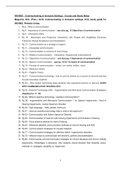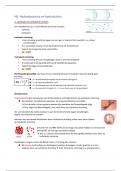INC4803 – Communicating in Inclusive Settings - Course and Study Notes
Maguvhe, M.O. (Prof.). 2018. Communicating in inclusive settings. Only study guide for
INC4803. Pretoria: Unisa.
1. Pg 2 - What is communication
2. Pg 4 – Importance of communication – see also pg. 15 Objectives of communication
3. Pg 9 – Information filters
4. Pg 10 - Meaningful and Productive Interactions with People with Disabilities Enhances
Tolerance, Mutual Acceptance and Socialisation
5. Pg 10 – Communication as a strategy of support
6. Pg 11 – Accessible communication
7. Pg 13 – Communication is inclusive of many things
8. Pg 13 – Modes of communication – Interpretive, interpersonal, presentational
9. Pg 15 – Objectives of communication – see also pg. 4 Importance of communication
10. Pg 16 – Means of communication – see pg. 18 for 10 means of communication
11. Pg 19 – Formats of communication – verbal, non-verbal, written, visual
12. Pg 25 – Bandura’s theory
13. Pg 27 – Paiget’s Theory
14. Pg 27 – Communication technology / how to use the internet as a source of inclusive learning
for post-secondary students
15. Pg 34 – How modern technology helps students who experience barriers to learning (GOES
WITH COMMUNICATION TECHNOLOGY)
16. Pg 36 - Assistive Technology (AAC – Augmentative and Alternative Communication Strategies)
(Heading for 17 -19)
17. Pg 36 - What is assistive technology / assistive communication?
18. Pg 38 - Augmentative and Alternative Communication – for Speech Impairments / Hard of
Hearing Impairments / Autism Spectrum Disorder
19. Pg 45 – Sign language – hello, please, thank you
20. Pg 47 - How can assistive technology help a child on the spectrum?
21. Pg 53 - Communication with Autism Spectrum Disorder
22. Pg 59 - Communication for learners with hearing impairments and hardness of hearing
23. Pg 66 – Extra assistive devices for hard of hearing
24. Pg 64 - Difference between communication methods for hard of hearing and ASD
25. Pg 69 – Communication strategies for visually impaired
26. Pg 77 – Communication strategies for attention deficit / hyperactivity disorders
27. Pg 78 – effective ways to communicate with learners, parents and stakeholders
28. Pg 88 – Extra theories and communication strategies for chronic diseases and chronic mobility
impairments, WhatsApps in education, why students should disclose their disability status,
methods vs. strategies, disability vs. impairment
1
, 1. What is Communication
Communication is the imparting or exchanging of information by speaking, writing or using
some other medium.
Communication can be defined as the way we convey our thoughts
Communication is the manner that information is traded between people – whether intended
or unintended
Communication is a process of expressing and interpreting messages. Communication
happens when the aim of a message is understood by the receiver.
It is about sending and receiving messages sent between the sender and the receiver
People convey their thoughts and feelings by various methods
These include verbal and non-verbal means such as speaking (verbal), (non-verbal) writing or
with body language / movement and the use of facial expressions
Information can be traded by means of a shared set of symbols, signs or behaviour
Communication can occur in different ways between individuals
People with disabilities can accept information in a variety of ways
There are various aspects involved in the communication process. Every process of
communication will contain these aspects:
• The sender – the communicator
• The message – information / content being exchanged
• The receiver(s) – the participants
• The communication channel, context and media used
Communication affects our lives in general
Communication is information that is transported from one person to another person who finds
meaning, representation of the message and gives feedback through behaviour and speech.
The sender sends the message to the receiver.
It gets encoded by the sender and decoded by the receiver.
The receiver then may give feedback to the sender.
Feedback is essential as it lets the sender know whether the message has been conveyed
correctly and if the message has been understood by the receiver.
Feedback helps control the communication process.
Noise and context can both affect the effective sending and receiving of the message.
Communication is creating a message from A, transferring the message from A to B,
generating of meaning by B, the message is therefore understood by a continuous exchange
of verbal and non-verbal cues. Communication is sharing information by speaking, writing,
observing and listening.
2
,The process of communication can have two parts – the information part and the social
element (how they are going to react and send / convey information and messages to others)
of the message and information sent.
Communication can occur in a one-way direction where the sender sends the message to the
receiver, but does not receive feedback. Examples of this way include giving a presentation,
being an author of a book, acting in a movie, singing a song or communicating by means of a
pamphlet.
Communication can also occur in a two-way direction where the sender sends the message
(verbal and non-verbal message) and the receiver is able to give feedback to the sender. This
is evident when communication happens on a one-on-one basis e.g., classroom discussions,
a dialogue between two or more people.
It is two-way communication because participants share the task of sending and receiving
verbal and non-verbal messages.
Communication can take on various formats.
These formats are verbal, non-verbal, written, visual and listening.
Verbal communication is a combination of sounds, words, speech and language. Verbal
communication is an effective method of expressing our thoughts and emotions with words.
There are different types of verbal communication.
These include intrapersonal communication, interpersonal communication, small group
communication and public communication. Non-verbal communication is communication that
doesn’t use any form of sound or words. Instead, it is communicating through body language
such as the likes of facial expressions, gestures, posture and tone of
Body language is a natural way to communicate and it is conveyed mostly through an
unconscious means and it can broadcast true emotions and intentions.
It is when you give cues that are non-verbal that expresses a message.
Body language is the use of physical behaviour, expressions and mannerisms to communicate
non-verbally, often done instinctively rather than consciously.
Non-verbal communication can include facial expressions, gestures, movements, visual
characteristics and tone of voice. Written communication occurs between a sender and a
receiver when written symbols e.g., words are used.
It is the most common format of communication in business through modes such as emails,
letters, bulletins, procedure and policy manuals, instructions, job descriptions, reports and
memos.
3
, Visual communication is when you use something visual e.g., a picture to express a message.
The visual symbols one can use to convey a message include pictures, graphs, road maps,
diagrams, shapes, logos, mind-maps and colour. Listening is the capability of accurately
receiving and interpreting the message sent by the sender to the receiver.
In order to successfully communicate, listening is crucial.
Communication is dynamic in nature and has various elements that must be effectively
controlled and managed to ensure that the correct information is conveyed.
2. The Importance of Communication
Communication is the sending and receiving of messages; sent from a sender to a receiver.
Feedback from the receiver to the sender can sometimes occur, depending on whether the
communication is a one-way transaction or a two-way transaction process.
If it is a two-way transaction process, then the receiver will give feedback to the sender.
Technology has enhanced and modernised means of communication between people.
No longer are people subjected to a limited number of options for ways of communicating with
each other.
Importance of communication
● For personal growth – people find themselves, form relationships with others and
define their relationship with the world
● To provide activities that require students to go beyond their traditional role as
responder to the teacher’s questions
● To provide opportunities for students to use the language in meaningful interaction with
others, and to negotiate meaning in authentic contexts in interpersonal communication
● To provide opportunities for students to engage in self-expression in interpersonal and
presentational communication
● To provide opportunities for students to hear and read a great deal of comprehensible
and authentic language in interpersonal and interpretive communication
● To provide opportunities for students to engage in real-life tasks
● To provide a nonthreatening environment in which students’ affective filter is lowered
People communicate for a variety for a variety of reasons.
They communicate to create.
This includes communicating ideas, facts, emotions and opinions.
Poor communication can bring much harm to situations.
4





